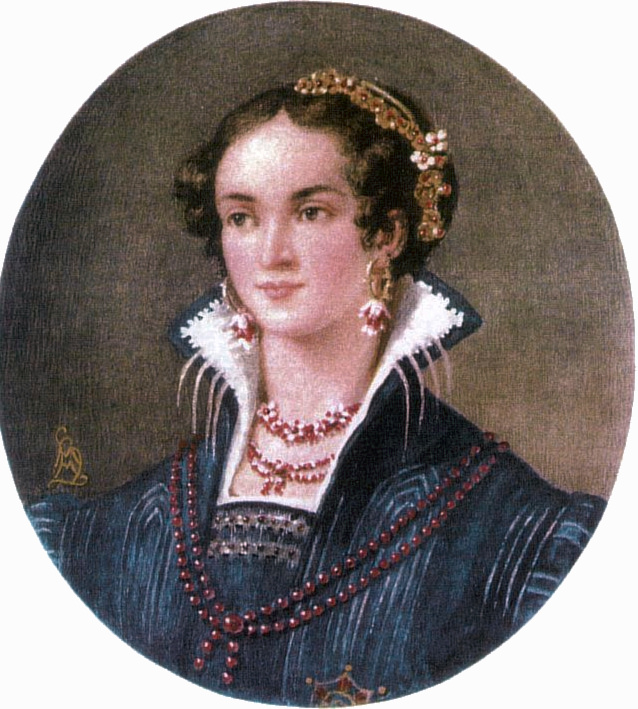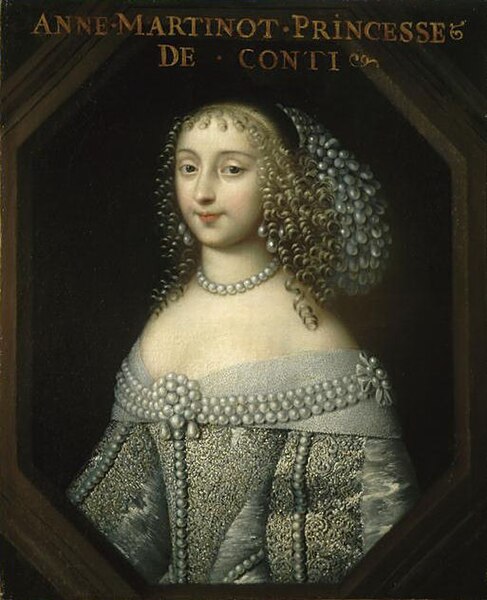The Martinozzi Sisters
 |
| Laura Martinozzi Duchessa di Modena |
Duchess of Modena & Reggio, 1658.
" . . . Laura Martinozzi was asked in marriage at sixteen years of age, and wedded by Alphonse de Modene, without his even seeing her. The Prince of Modena wanted at that time the support of France against Spain, and, as a result of his son's marriage, he was made generalissimo of the French troops in Spain. . . Alphonse was less warlike than his father, on on the death of the latter, and his succession to the throne, he, with the concurrence of his uncle---the cardinal---negotiated peace with Spain. He did not, however, live to enjoy it long, for, afflicted with gout, he died at twenty-eight years of age, in 1662, leaving two children, a boy and a girl, and Laura as regent. The boy was unfortunately as afflicted as the father; and when Laura, after ruling for some years with great capacity, withdrew to a convent, leaving the throne to her son, he soon sank, the house of D'Este dying with him." (Bentley's Miscellany, Vol 44: 412)
 |
| Anne Marie Martinozzi Princesse de Conti @Wikipedia |
(1637-1672)
Italian aristocrat & French court official
Superintendent of the Queen's Household 1657-1666
Daughter of: Girolamo Martinozzi & Laura Margherita Mazzarini.
Superintendent of the Queen's Household 1657-1666
Daughter of: Girolamo Martinozzi & Laura Margherita Mazzarini.
 |
| Armand de Bourbon Prince de Conti |
" . . . Conti had earlier led a worldly and dissolute life---he had boasted of an incestuous relationship with his own sister, had kept numerous mistresses, including one who remained in his chateau for some time after his marriage; had contracted the pox during some carnival philandering soon after his marriage and ha passed it on to his bride. . . However, in 1656, he finally made good on past promises to become devout, and he began to decry all wordily pursuits including the theater. . . ." (Memoirs: 49)
"The first surprise that Mazarin reserved for the good Parisians on his restoration to power was the marriage of Anne-Marie Martinozzi with the Prince de Conti, and that at the very moment when parliament, in red robes assembled, was condemning his brother Conde to death. He effected, indeed, an alliance with one royal prince at the very moment that he was carrying out the destruction of another." (Bentley's Miscellany, Vol 44: 409)
"Armand de Bourbon, Prince de Conti, who was at this time about thirty-four years of age, had been originally destined for the Church,and thought he had resisted the imposition of hands ecclesiastical, had received as his appanage many rich abbeys, such as Saint-Denis, Cluny, and Lerens. In person, he was short and slightly deformed, defects which were atoned for by a strikingly handsome face and charming manners. . . ." (Five Fair Sisters: 39)
"The Prince de Conti had certainly every reason to consider himself a fortunate manor not only did his marriage restore to him all the offices and dignities he had lost by his conduct during the Fronde, plus a handsome dowry, the government of Guienne, and a magnificent hotel on the Quai Malaquais, which the Cardinal, in a fit of generosity, subsequently erected for him at his own expense, but it brought him an extremely beautiful wife, who joined to her loveliness 'much sweetness of temper, much intelligence, and good sense.'" (Five Fair Sisters: 39)
Anne-Marie Martinozzi's lovers were:
1 Duc de Candale.
2. Prince of Parma.
3. Francois-Rene Crespin du Bec (1621-1688)
Marquis de Vardes, Comte de Moret, Baron de La Bosse; Seigneur de Montmorin
Son of: Rene II Crespin du Bec & Jacqueline de Beuil, Comtesse de Moret.
Husband of: Catherine Nicolay.
" . . . A certain Marquis of Vardes, as handsome as Candale, and far more agreeable, was, it appears, however really more to be dreaded. Madame de Conti was, in fact, a woman of the world before she became a saint. She passed, by degrees, from indifference to faith. She began by reforming her toilet and visiting the poor. She sold, in a year of scarcity, full 60,000 crowns' worth of jewellery, to feed those who were in vain." (Bentley's Miscellany, Vol 44: 411)
"The king, in the mean time having fallen in love with La Valliere, he assigned to the Marquis of Vardes, of whom we have before spoken, the task of taking Olympe off his hands. This Vardes was the son of one of Henry IV's mistresses, and his affairs of heart and honour were equally numerous. The most brilliant of his conquests, and the most touching of his victims, is said to have been the Duchess of Roquelaure. . . The duchesse abandoned like all the rest by Vardes, died of grief at the early age of twenty-three. The Prince of Conti once found him . . . by the bedside of his wife, Anne-Marie Martinozzi, and that a few moments after he had declined taking a drive with him, on the plea of fatigue after hunting. Vardes was as successful with Olympe as he had been with Anne-Marie; her passion for the marquis became so ungovernable as to be manifest to all except to her husband, who, when a quarrel happened between the lady and her lover, went to bring him back and to effect a reconciliation. This 'charming man' deceived and abused the friendship of the king, his master, that of Madame, the king's sister, and that of all his friends and mistresses in their turn. . . ." (Bentley's Miscellany, Vol 44: 413)
Effect of the affair & aftermath: "At length an order of the king's came like a thunder-clap to take away her dear De Vardes from Madame de Soissons. He was imprisoned in the Bastille, and removed thence to the citadel of Montpelier. The count and countess were also exiled for a time, and then restored ain to favour. . . ." (Bentley's Miscellany, Vol. 44: 413)
No comments:
Post a Comment